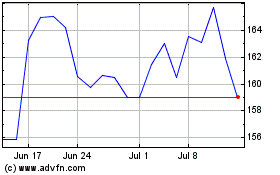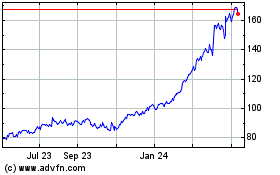Why Thomas Edison Would Not Be Happy About GE's Latest Deal
May 23 2018 - 12:03PM
Dow Jones News
By Thomas Gryta
General Electric Co.'s deal to spin off its railroad business to
Wabtec Corp. unites the creations of two of the 19th century's most
famous inventors and rivals: Thomas Edison and George
Westinghouse.
Both men filed their first patents in the 1860s and competed in
the development of products that used electricity. Edison and
Westinghouse famously battled over the future of electrical
distribution -- alternating current vs. direct current -- resulting
in insults and publicity stunts, including Edison electrocuting
animals in his New Jersey laboratory in an unsuccessful attempt to
illustrate the dangers of Westinghouse's AC.
Their work was the foundation of massive conglomerates that
fought on many fronts. Westinghouse founded the Westinghouse Air
Brake Co. in 1869 and the Westinghouse Electric Corp. in 1886.
Wabtec, formally known as Westinghouse Air Brake Technologies
Corp., is the successor to his first company.
General Electric was created when financier John Pierpont Morgan
orchestrated the 1892 merger of Thomas-Houston International
Electric Co. and Edison General Electric Co.
GE ultimately fared better than Westinghouse, but both took
similar paths in recent decades, owning major industrial operations
and prestigious media properties and dabbling in risky financial
bets. The two companies didn't overlap or work together much, but
were central to the 1919 formation of Radio Corporation of America,
or RCA, and both owned stakes in the operation, along with AT&T
and United Fruit.
While the two men are often characterized as bitter rivals in
articles, books and film, it isn't clear that they personally
disliked each other, said Leonard DeGraaf, archivist at the Thomas
Edison National Historical Park in West Orange, N.J.
According to a 1888 letter from the archives, Westinghouse
invited Edison to visit his facilities in Pittsburgh, and recalled
a tour that Edison gave him of his workshop in Menlo Park, N.J. He
even suggested that their two companies work together.
"I believe there has been a systematic attempt on the part of
some people to do a great deal of mischief and create as great a
difference as possible between the Edison Company and The
Westinghouse Electric Co., when there ought to be an entirely
different condition of affairs," Westinghouse wrote in the
letter.
Edison declined the invitation, according to Mr. DeGraaf, and
the public rivalry continued. As the electrical battle intensified,
Edison told the New York Herald in 1889 that "Westinghouse used to
be a pretty solid fellow, but he lately has taken to
shystering."
It was widely reported that Edison also said, "Tell Westinghouse
to stick to air brakes," a reference to an early invention.
Trains were of interest to both men. Westinghouse invented his
brake system when he was just 22 years old after witnessing a train
accident. The technology would end the days of brakemen running on
top of train cars to individually apply the brakes, a system that
often required miles for a train to stop.
Edison conducted experiments on electric traction and railways
in the 1880s and 1890s, including building a short track in New
Jersey for testing. Shortly after its formation, GE installed an
electric train line for the 1893 Chicago World's Fair. The line was
more than 3 miles long and the fare was 10 cents per rider. The
accident-free operation was seen as a boon for the future of
electric trains.
Later, both Westinghouse and GE were involved in bids to
electrify New York's Grand Central Terminal, with GE ultimately
winning the battle with its locomotive.
GE Transportation, as the railroad business that Wabtec is
buying is known, stopped making pure electric locomotives in the
1960s. It now leads the market for diesel-electric freight
locomotives, which use a massive engine to generate electricity for
motors. The design, which GE helped pioneer in 1924, is a power
plant on rails.
The Westinghouse Electric name has mostly faded from memory. It
acquired CBS in 1995, taking its name, and the industrial
operations were sold off to buyers including Siemens AG and a
British company. Toshiba bought some of the assets in 2007, but
Westinghouse Electric filed for bankruptcy last year after making a
bad bet on a new design of nuclear power plants. A Canadian
conglomerate agreed to buy the company out of bankruptcy.
Wabtec's corporate headquarters are still located where its
founder broke ground in 1889 in Wilmerding, Pa.
Although the combined company will keep the Wabtec name, GE
locomotives aren't going to stop running anytime soon. Wabtec has
licensed the GE brand and logo for a minimum of 10 years as part of
their combination.
Write to Thomas Gryta at thomas.gryta@wsj.com
(END) Dow Jones Newswires
May 23, 2018 11:48 ET (15:48 GMT)
Copyright (c) 2018 Dow Jones & Company, Inc.
GE Aerospace (NYSE:GE)
Historical Stock Chart
From Aug 2024 to Sep 2024

GE Aerospace (NYSE:GE)
Historical Stock Chart
From Sep 2023 to Sep 2024
